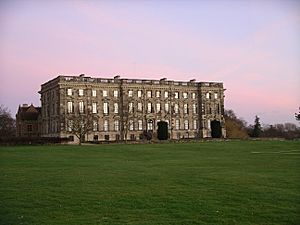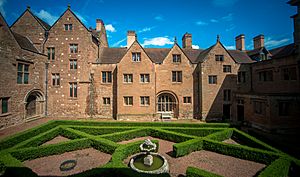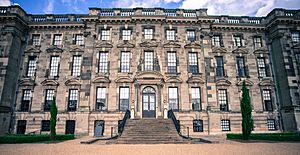Stoneleigh Abbey facts for kids
Stoneleigh Abbey is a grand country house and estate located south of Coventry in England. It's near the village of Stoneleigh, in Warwickshire. The Abbey building itself is very old and important, listed as a Grade I building. This means it's a special historical site!
Contents
A Look Back in Time
In 1154, a long time ago, King Henry II gave some land in the Forest of Arden to a group of monks called Cistercians. They came from Staffordshire and built an abbey here. You can still see parts of the original Abbey buildings today, especially the old Gatehouse from the 1300s.
From Monks to a Family Home
After the time when many monasteries were closed down in England (called the Dissolution of the Monasteries), a man named Sir Thomas Leigh bought the estate in 1558. He was the Lord Mayor of London. Later, King Charles I gave the Leigh family a special title because Sir Thomas had offered him a place to stay when the gates of Coventry were closed to the king during the English Civil War.
A house was built on the site of the old monastery. This house now forms the north and east parts of the current building. The Leigh family lived here from 1561 all the way until 1990! Over time, the Leigh family became the biggest landowners in Warwickshire.
Building the Grand West Wing
Between 1714 and 1726, a huge new part of the house was built. It was designed by an architect named Francis Smith of Warwick. This new section, called the West Wing, was very grand with four floors and fifteen sections. It was made of beautiful silver-colored stone, which was very popular back then.
One of the most amazing rooms in the Abbey is the Saloon. It's known for its incredible plasterwork, which is like fancy decorations made from plaster on the walls and ceiling. It's considered one of the best examples of this style in England.
Gardens and Cricket
If you look out over the River Avon, you can see changes made by Humphry Repton. He was a famous landscape designer who worked on many large country houses.
In 1806, the estate went to Rev. Thomas Leigh. He visited with his cousin, Cassandra Austen, and her two daughters, Cassandra and Jane. One of them was the famous writer Jane Austen! She even wrote about Repton in her book Mansfield Park.
When Repton worked at Stoneleigh, he wanted to add an arcade (a covered walkway) to the house. That didn't happen, but he did change the river's path. He flooded a part of the river to create a "mirror lake." From a special spot across the river, you can see the house perfectly reflected in the water! There were also small flower gardens in front of the house, where grass is now. You can explore other features like the wilderness and old bridges by walking the paths.
The stables, riding school, and conservatory nearby are also important historical buildings.
Long ago, this side of the house had sheds and other farm buildings. But in the early 1800s, these were moved away for better health and to create a nicer view from the new West Wing. This also made space for a cricket pitch! William Henry Leigh's son, Edward Chandos, loved cricket. His father even gave a silver sixpence to any boy who could hit a ball hard enough to break a window! The cricket pitch is still used today by the Stoneleigh Cricket Club. It has even been called the most beautiful cricket pitch in England by Wisden.
Famous Visitors
One room in the West Wing has a statue of the famous poet Lord Byron. Chandos Leigh and Lord Byron were friends from school. They even had dinner together the day before Byron left England for the last time in 1816.
Queen Victoria herself stayed at Stoneleigh Abbey for two nights in 1858. She was given a special suite of five rooms with white and gold furniture, as that was her favorite style.
Stoneleigh Abbey Today
In 1946, Stoneleigh Abbey was one of the first grand homes to open its doors to the public. Sadly, in 1960, a big fire caused a lot of damage to the West Wing.
In 1996, Lord Leigh gave ownership of Stoneleigh Abbey and its 690 acres of land to a charity called the Stoneleigh Abbey Preservation Trust. Between 1996 and 2000, the Abbey was beautifully restored. This huge project received help from grants, including a large one from the Heritage Lottery Fund. More than 1,000 tons of special stone were used to fix the outside of the West Wing, and many skilled stonemasons worked on it.
The upper floors were turned into apartments, and homes were created in the West, South, and East Wings. Later, a new, independent charity was set up to make sure the Abbey would be safe for the future. This new charity is led by a local businessman, Tony Bird. In the early 2000s, two groups of houses were built in the Abbey grounds.
Today, Stoneleigh Abbey is still open for people to visit. The old Orangery (a building for growing orange trees) is now a lovely tea room.
Restoring the Pump House
A historic pump house and water wheel at Stoneleigh Abbey have also been restored. This was part of a big project to save and protect old structures on the grounds. It also helped bring back many of the views and walks that Humphry Repton designed. The chairman of the Stoneleigh Abbey Charitable Trust, Tony Bird, oversaw the full restoration of the large water wheel and an 1851 water pump.
The repairs to the Pump House were partly paid for by Natural England. This included fixing the roof and cleaning off years of lime scale. The water wheel itself was also restored. A trustee, Dorothy Ingle, said it's wonderful to see the wheel turning again. She explained that while the wheel doesn't pump water to the house anymore, it still shows how the garden and house worked over 100 years ago. The pump house was built in 1851 on the site of the Abbey's old medieval water mill on the River Avon. Visitors can now see the restored pump house as part of the Abbey's country park.





